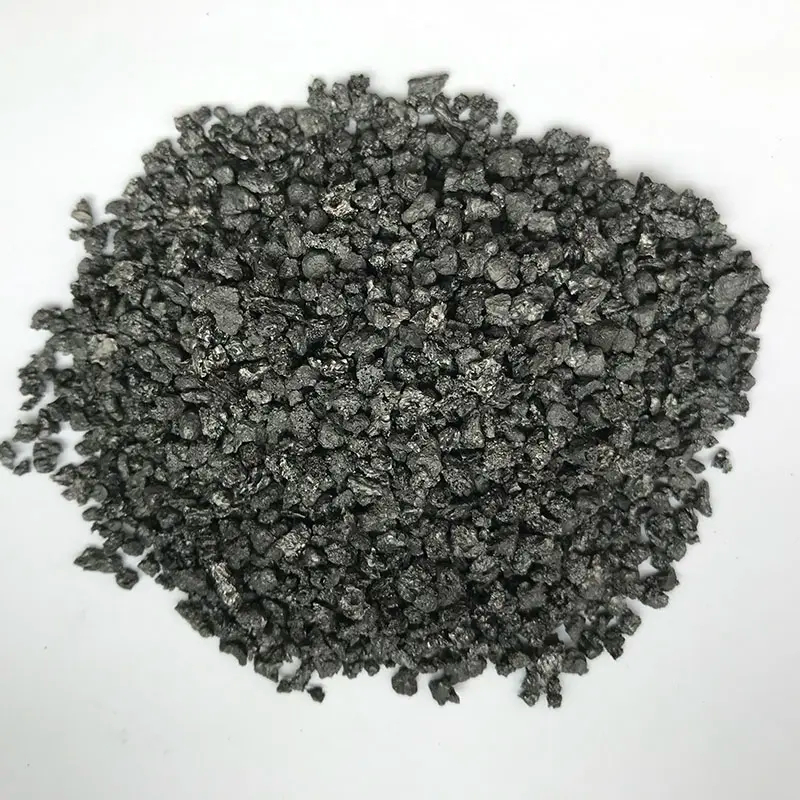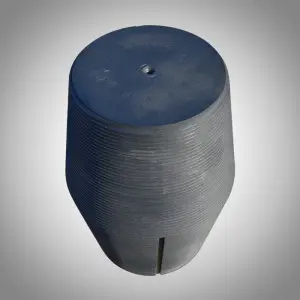In the heart of a modern steel mill, the electric arc furnace (EAF) is a roaring beast, melting tons of scrap steel at thousands of degrees Celsius. At the center of this inferno are the graphite electrodes, the colossal conductors that channel the immense power needed to smelt metal. However, when one of these electrodes breaks, the beast falters. An electrode breakage is more than an inconvenience; it's a catastrophic failure that halts production, risks damaging the furnace, and incurs significant financial losses. Understanding the cause of graphite electrode breakage is the first, most critical step toward prevention.
My name is Frank Liu, and for over 30 years at Hebei Heyuan New Material Technology Co., Ltd., I have dedicated my career to manufacturing high-performance graphite electrodes. I've spoken with hundreds of procurement directors and metallurgists like Peter Kovac in Germany, who know that the stability and reliability of their electrodes in electric furnace steelmaking are directly tied to their plant's profitability. This article is for them. We will move beyond the surface-level issues and explore the complex interplay of factors—from the internal quality of the electrode to the subtle dynamics of furnace operation—that can lead to electrode breakage.
What Really Happens When a Graphite Electrode Breaks in an Electric Arc Furnace?
When a graphite electrode snaps during the smelting process, the consequences are immediate and severe. First, the powerful electric arc is extinguished, and the melting process stops cold. The broken section of the electrode, which can weigh hundreds of kilograms, falls into the molten steel bath or onto the unmelted scrap. This introduces an excess of carbon into the melt, potentially throwing the steel chemistry off-spec and requiring costly corrective actions.
The operational impact is even greater. The furnace must be shut down. The broken stump must be carefully removed, and a new graphite electrode column must be assembled and installed. This process can take hours, representing significant production downtime and lost revenue. In a worst-case scenario, the falling electrode can damage the furnace lining or water-cooled panels, leading to even more extensive and expensive repairs. These electrode breakage accidents are the primary pain point for any EAF steelmaking operation, turning a consumable tool into a major liability.
How Crucial is the Internal Quality of the Electrode Itself?
The journey to preventing breakage begins long before the electrode ever reaches the furnace. It starts with the quality of the electrode itself. The internal quality of the electrode—its structural integrity, density, and material composition—is the foundation of its strength. A flaw introduced during manufacturing can create a weak point that is guaranteed to fail under the extreme stresses of the EAF.
High-quality graphite electrodes, particularly ultra-high power graphite electrodes (UHP), are made from premium needle coke. This raw material provides low electrical resistivity and, crucially, low thermal expansion, which gives the electrode superior thermal shock resistance. An analysis of graphite electrode properties will show that a well-made electrode has high mechanical strength and uniform density. If a manufacturer cuts corners, using inferior raw materials or having poor quality control during the baking and graphitization stages, the resulting electrode will have internal cracks, low density spots, or poor crystalline structure. This is the primary reason why the shock resistance of the electrode might be compromised, making breakage almost inevitable.
Are Your Furnace Operations Causing the Breakage?
While electrode quality is paramount, even the best graphite electrode can be broken by improper furnace operations. The environment inside an EAF is violent and unpredictable, especially during the initial meltdown phase. The way scrap steel in the furnace is charged and melts has a direct impact on the electrodes in electric furnaces.
A major operational cause of breakage is the formation of "bridges." This happens when the scrap melts unevenly, leaving large, solid chunks of material that can shift or collapse suddenly. If the furnace has formed a bridge structure, it can fall against the electrode, delivering a powerful physical blow that can easily cause the electrode to break. Furthermore, if the scrap is non-conductive at the start, the electrode regulator cannot accurately judge the distance to the melt pool. This can cause the electrode to drive down too hard, resulting in a mechanical fracture. Proper electrode operation technology and careful scrap management are essential to protect the graphite electrode from these physical hazards.

Why Does the Connection and Clamping of a Graphite Electrode Matter So Much?
A graphite electrode column in a furnace is not a single piece; it's composed of several individual electrodes joined together by tapered graphite nipples. The electrode joint is a point of high mechanical and thermal stress, and it is a common location for breaks. A proper connection of electrodes is vital. If the joint is too loose, it can overheat due to high electrical resistance, weakening the nipple. If it's too tight, it can create excessive stress on the threads at the end of the electrode body, leading to cracks.
The clamp (or holder) that grips the electrode column is another critical area. Improper clamping pressure—either too weak or too strong—can create stress concentration points. Breaking near the electrode clamping point is often a sign of issues with the holder's contact pads or hydraulic system. The area formed by the graphite electrode and the holder must be clean and make perfect contact to ensure both a secure grip and efficient transfer of the electric current into the furnace. If the electrode and the holder cannot maintain a stable connection, it puts immense strain on the entire column.
What Role Does Thermal Shock Play in Electrode Failure?
Thermal shock is the stress placed on a material when it undergoes a rapid change in temperature. Graphite electrodes experience this constantly. They are heated to incandescent temperatures in seconds by the electric arc and then can be rapidly cooled by contact with cold scrap or the addition of fluxes. This rapid cycling of temperatures causes the material to expand and contract, creating internal stresses.
An electrode with poor thermal shock resistance is highly susceptible to cracking and failure under these conditions. The thermal stress at the electrode can exceed the material's mechanical strength, causing a fracture. This is particularly common at the end of the electrode, where the temperature gradient is steepest. Breakage caused by the poor thermal shock properties of an electrode is a clear indicator of low-quality manufacturing. Superior thermal shock resistance, a key index of the electrode, is a hallmark of premium graphite electrodes in steelmaking.

Can Electrical Factors in the EAF Lead to Electrode Breakage?
The forces at play inside an electric furnace are not just physical and thermal; they are also electromagnetic. The immense arc current flowing through the electrodes in electric furnace steelmaking generates powerful magnetic fields. These fields interact, creating significant sideways forces on the electrode columns, especially in a three-phase AC furnace.
The electrode is subjected to electromagnetic forces that cause it to vibrate. The magnitude of this force is proportional to the square of the current, so it becomes a major factor in high-power furnaces. If the electrode regulator will control the power in a way that causes sudden, large swings in current, the resulting electromagnetic jolts can contribute to mechanical fatigue and eventual fracture of graphite electrodes. To detect the arc current variations and manage them smoothly is a key function of a modern furnace control system aimed at protecting the graphite electrode.
How Does Mechanical Vibration Affect a Graphite Electrode in an EAF?
Every object has a natural resonant frequency. A graphite electrode column, being a long, slender object, is no different. During the smelting process, the electrode is constantly subjected to vibrations from multiple sources: the collapse of scrap, the turbulence of the molten bath, and the electromagnetic forces mentioned earlier.
The real danger occurs when the electromagnetic force vibration frequency or the mechanical vibration frequency from furnace operations gets close to or synchronized with the natural resonant frequency of the electrode column. This creates a resonance effect, dramatically amplifying the vibrations, much like pushing a child on a swing at just the right moment. This amplified vibration can quickly exceed the mechanical strength of the electrode or its joints, causing a fatigue failure. The vibration frequency of the electrode must be kept out of this dangerous resonant range through stable furnace operation.
"I've seen situations where a steel plant experienced a series of unexplained breaks. After investigation, we found that the harmonic frequency from their power system was aligning with the natural frequency of their specific electrode columns. It's a complex problem of graphite failure that requires a deep understanding of both metallurgy and physics." - Frank Liu

What are the Different Types of Graphite Electrode Breakage and Their Causes?
Not all breaks are the same. Analyzing where and how the electrode is broken can provide valuable clues about the root cause. This helps operators and suppliers work together to solve the problem.
| Breakage Type | Common Location | Likely Causes |
|---|---|---|
| Body Break | Middle of an electrode body | Severe mechanical impact (falling scrap), extreme thermal shock, or a significant internal quality defect. |
| Nipple Break | At the joint between two electrodes | Improper tightening torque, poor joint alignment, oxidation of the joint, or resonance vibrations. |
| Socket Crack | At the threaded end of the electrode | Over-tightening of the nipple, poor machining of threads, or severe stress from a bent electrode column. |
| Tip Shedding | At the lower end of the electrode | Often not a full break, but spalling or flaking caused by the poor thermal shock resistance or excessive oxidation. |
Understanding the probability of breaking near a specific point helps focus troubleshooting efforts. For example, a high frequency of nipple breaks points toward improving the use of electrodes in electric furnace assembly procedures.
How Can Steelmakers Proactively Prevent Graphite Electrode Breakage?
Preventing electrode breakage requires a holistic approach that combines good purchasing, careful operation, and diligent maintenance. These operations can easily cause failure if not managed correctly. Here are actionable steps steelmakers can take:
- Scrap Management: Charge the furnace with a balanced mix of scrap to promote a stable, even meltdown. Avoid charging massive, heavy pieces directly under the electrodes.
- Electrode Handling and Assembly: Always use the correct tools and torque settings when joining electrodes. Ensure threads are clean and alignment is perfect to create a strong electrode joint.
- Furnace Regulation: Utilize modern regulator systems to maintain a stable arc and avoid sudden current fluctuations. The electrode regulator control electrode movement smoothly to prevent mechanical shock.
- Operator Training: Train furnace operators to recognize the signs of a potential bridge formation or unstable arc. For example, if the electrode regulator cannot accurately judge that the electrode is in a stable position and the second phase electrode to continue to drop seems erratic, it may indicate a problem.
- Regular Inspection: Routinely inspect electrode holders, clamps, and the hydraulic systems to ensure they are functioning correctly.
Why is Choosing the Right Supplier Key to Ensuring the Stability of Graphite Electrodes?
Ultimately, the effort to reduce electrode breakage is a partnership between the steelmaker and the electrode manufacturer. A supplier's role extends far beyond simply shipping a product. A reliable supplier is your first line of defense against the factors of graphite failure.
As a manufacturer with over three decades of experience, we at Hebei Heyuan New Material Technology Co., Ltd. understand that the quality and stability of graphite are non-negotiable. Our investment in premium raw materials, like needle coke for our UHP Graphite Electrodes, and our stringent quality control are designed to eliminate the internal quality of the electrode as a cause of failure. We provide not just electrodes, but also the technical expertise to help our customers optimize their operations. We understand Peter Kovac’s pain points because we have built our business around solving them—ensuring consistent quality, reliable logistics, and clear, knowledgeable communication. A good supplier doesn't just sell you a graphite electrode; they provide peace of mind.

Key Takeaways
Preventing graphite electrode breakage is a multifaceted challenge, but it is manageable with the right knowledge and partnerships. Here are the most important things to remember:
- Quality is Foundational: Breakage prevention starts with sourcing high-quality graphite electrodes from a reputable manufacturer with proven expertise.
- Operations Matter: Careful scrap management and smooth furnace regulation are crucial to protect the electrode from mechanical impact and thermal shock.
- Connections are Critical: Proper handling, assembly, and clamping of the electrode column, especially at the joints, are vital to maintaining its structural integrity.
- Forces are Complex: Acknowledge the powerful thermal, electrical, and mechanical forces at play in the EAF and take steps to mitigate their impact through stable control.
- Your Supplier is Your Partner: Choose a supplier who understands your challenges and can provide not only a reliable product but also the technical support needed to optimize performance and prevent costly failures.
Post time: 10 月-27-2025













